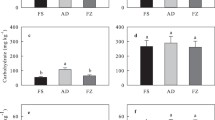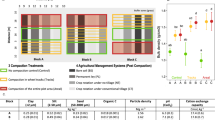Summary
Changes in numbers of various microbial groups in the interim between collection and analysis of a tropical soil were determined. Although the number of most organisms decreased as a result of storage, the percentage distribution of several groups increased. The greatest decreases occurred in the top layers of soil. Both the numbers and the relative distribution of actinomycetes increased after storage. The possible significance of this increase in the detection of fungistatic materials in soil is discussed. Numbers of fungi were higher after storage in all soil depths, except in the top layer where essentially no change occurred. The vertical distribution and relative frequency of isolation of fungal species after storage is presented. The percentage distribution of spore-forming and CO2-tolerant bacteria was higher after storage, but that of CO2-tolerant fungi was lower.
The significance of these results in soil microbiological studies, as well as possible causes of the changes, are discussed.
Similar content being viewed by others
References
Alexander, M., Marshall, K. C., and Hirsch, P., Autotrophy and heterotrophy in nitrification. Trans. VII Congress Intern. Soc. Soil Sci. 19602 586–591 (1960).
Allen, O. N., Experiments in Soil Bacteriology. Burgess Publishing Company, Minneapolis, Minnesota (1951).
Birch, H. F., The effect of soil drying on humus decomposition and nitrogen availability. Plant and Soil10 9–31 (1958).
Bisby, G. R., Timonin, M. I., and James, N., Fungi isolated from soil profiles in Manitoba. Can. J. Research C13 47–66 (1935).
Burgess, Alan and Fenton, Enid, The effect of carbon dioxide on the growth of certain soil fungi. Trans. Brit. Mycol. Soc.36 104–108 (1953).
Dobbs, C. G. and Hinson, W. H., A widespread fungistasis in the soil. Nature172 197–199 (1953).
Eno, Charles F., Nitrate production in the field by incubating the soil in polyethylene bags. Soil Sci. Soc. Amer. Proc.24 277–279 (1960).
Eylar, O. R., Jr. and Schmidt, E. L., A survey of heterotrophic micro-organisms from soil for ability to form nitrite and nitrate. J. Gen. Microbiol.20 473–481 (1959).
Fred, E. B. and Waksman, S. A., Laboratory Manual of General Microbiology. McGraw-Hill Book Co., Inc., N.Y. (1928).
Harmsen, G. W., Onderzoekingen over de Aërobe Cellulose-ontleding in den Grond. Ph. D. Dissert., Landbouwhoogeschool, Wageningen, Holland (1946).
Hessayon, D. G., Fungitoxins in the soil. II. Trichothecin, its production and inactivation in unsterilized soil. Soil Sci.75 395–404 (1953).
Jackson, R. M., An investigation of fungistatis in Nigerian soils. J. Gen. Microbiol.18 248–258 (1958).
Jackson, R. M., Some aspects of soil fungistasis. J. Gen. Microbiol.19 390–401 (1958).
James, Norman, Soil extract in soil microbiology. Can. J. Microbiol.4 363–375 (1958).
Jefferys, E. G. and Heming, H. G., Fungistasis in soils. Nature172 872 (1953).
Lebedjantzev, A. N., Drying of soil as one of the natural factors in maintaining soil fertility. Soil Sci.18 419–447 (1924).
Lu, K. C., Dawson, J. E., and Alexander, M., A microchemical method for detecting antifungal substances. Arch. Mikrobiol.33 182–185 (1959).
Martin, J. P., Use of acid, rose bengal, and streptomycin in the plate method for estimating soil fungi. Soil Sci.69 215–232 (1950).
Stevenson, I. L., Some observations on the microbial activity in remoistened air-dried soils. Plant and Soil8 170–182 (1957).
Stover, R. H., Flood-fallowing for eradication ofFusarium oxysporum f.cubense: III. Effect of oxygen on fungus survival. Soil Sci.80 397–412 (1955).
Takai, Yasuo and Harada, Isamu, Prolonged storage of paddy soil samples under several conditions and its effect on soil micro-organisms: I. On the drainable paddy clay loam soil. J. Sci. Soil Manure (Japan)30 117–122 (1959). Abstract in Soil and Plant Food5, 46 (1959).
Timonin, M. I., The micro-organisms in profiles of certain virgin soils in Manitoba. Can. J. Research C13 32–46 (1935).
Author information
Authors and Affiliations
Rights and permissions
About this article
Cite this article
Stotzky, G., Goos, R.D. & Timonin, M.I. Microbial changes occurring in soil as a result of storage. Plant Soil 16, 1–18 (1962). https://doi.org/10.1007/BF01378154
Received:
Issue Date:
DOI: https://doi.org/10.1007/BF01378154




